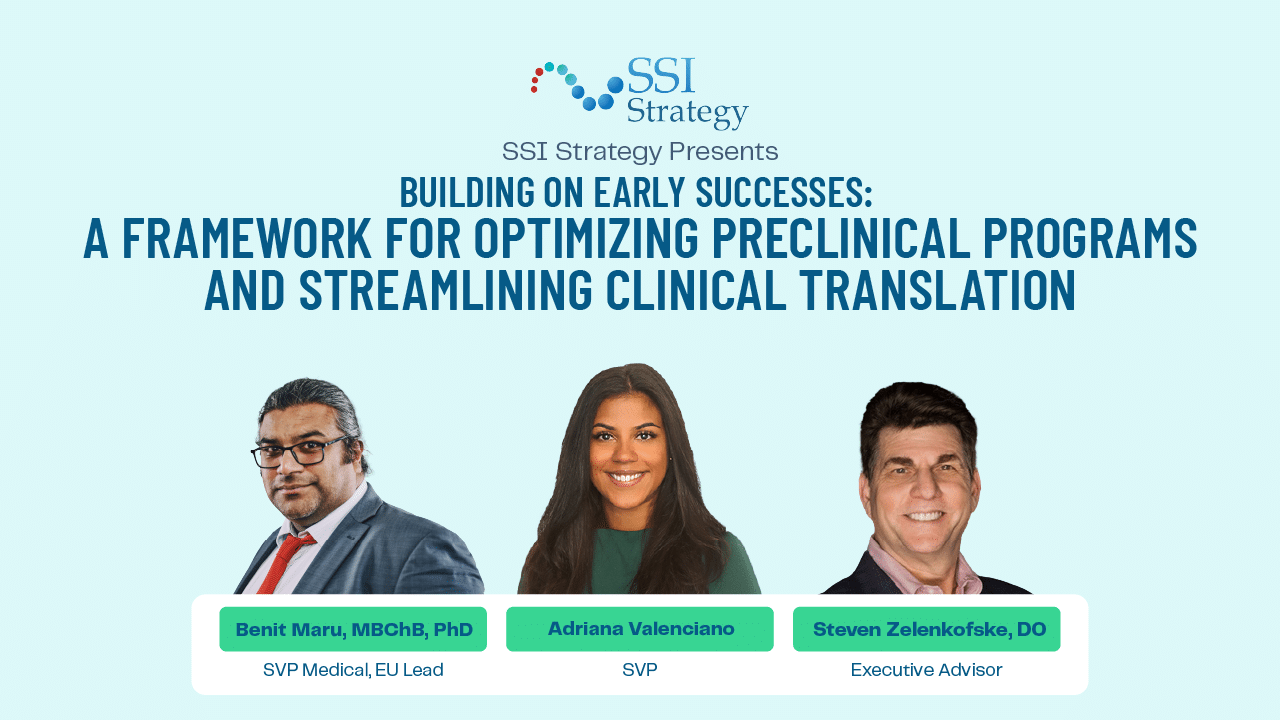The Importance of Strategic Planning in Biotech Development
Successful drug development in the biotech industry has never been more challenging. Companies face an increasingly risky funding landscape, intensifying regulatory requirements, and pressure to speed up timelines amidst resource constraints. However, early strategic planning can help mitigate risks and position programs for success. This was a key takeaway from a recent webinar hosted by SSI entitled “De-risking Development: Strategies to Achieve Biotech Milestones.” Industry experts Dr. Benit Maru and Dr. Yuri Maricich shared practical lessons learned on how to navigate complexity through comprehensive yet adaptable strategic planning, with strategic advisor Kate Goldstein facilitating the exchange of ideas.
Planning with the End in Mind
Both Drs. Maru and Maricich emphasized the importance of always planning backwards from the ultimate goal. For biotechs, this dual end goal includes achieving regulatory approval while also defining a compelling commercial profile. Too often, companies exclusively focus on the former without due consideration for factors like market access and reimbursement that are crucial for commercial viability. The speakers stressed having a well-thought-out strategy and development plan that aligns all functions and stakeholders around both approval and commercial success from day one.
This plan should not just sit on a shelf but become a living, governance tool to drive alignment and track progress. Regularly assessing internal and external changes allows the flexibility to course correct as assumptions evolve. As Maricich explained, maintaining nimbleness is paramount given the fluid nature of drug development and industry dynamics. The ability to quickly adapt based on new information and resource availability helps mitigate risk proactively.
Navigating a Changed Funding Environment
Biotechs now operate in an arguably riskier macro context. Recent safety issues, economic headwinds, and the wariness of risk-averse investors following the pandemic have made fundraising more difficult. At the same time, the pressure to speed development timelines to grab the next round of financing remains intense. Maru pointed out how these conflicting pressures underscore the importance of methodical strategic planning and risk mitigation through each stage-gate.
Developing such a plan requires considering an array of interconnected factors as laid out in SSI’s framework visual aid. Chief among these is crafting a thoughtful regulatory strategy, ensuring strong preclinical justification, selecting clinically and commercially meaningful endpoints, adequately resourcing CMC development, and thinking holistically about human capital needs. With many moving pieces, again flexibility is paramount, so the plan evolves hand-in-hand with the program.
The Value of External Collaboration
Both speakers emphasized that no single internal team could master all aspects of such complex planning and execution alone, regardless of organizational size. Building a collaborative network of experts is invaluable for tapping specialized advice across regulatory submissions, clinical trial design, biomarker development, and more. Leveraging external consultants on a fractional or project basis can also help backfill capacity gaps cost-effectively.
Maricich pointed out how interactions with regulators themselves have become increasingly collaborative as new science challenges established paradigms. External relationships can therefore aid not only in surfacing evolving regulatory perspectives early, but also potentially shaping guidance proactively for the betterment of patient communities. Capturing broad feedback through an ecosystem of stakeholders ultimately strengthens strategic decision making.
Building the Right Team Structure
As emphasized, leveraging human capital optimally is central to managing complexity and change. Maru pointed out that while talent may seem scarce, flexibility has grown, such that roles need not always be permanently filled internally. Fractional contracting is increasingly common out of necessity, enabling companies to tap broader expertise in a capital-efficient way.
Structuring cross-functional teams cooperatively around data-based problem solving, versus rigidly siloed functions, better facilitates strategic translation and agility. Regular touchpoints allow continually aligning strategy implementation amid shifting conditions and resource availability. As Maricich added, focus must remain on collaboration versus individual targets to maintain cohesiveness during inevitable navigation of challenges large and small.
Final Takeaways
In closing, Drs. Maru and Maricich reinforced biotech development’s intensifying demands in an environment of constrained resources. Strategic due diligence from program inception is paramount to de-risking pipelines and positioning assets for success at each critical stage-gate. A robust yet responsive plan incorporates regulatory and commercial imperatives holistically from the start.
Perhaps most importantly, an empowered team structure leveraging internal and external expertise sets the stage for the constant iteration that has become drug development’s reality. Only through meticulous upfront planning balanced with ongoing agility and stakeholder coordination can companies rise to meet the industry’s new normal of compressed timelines amid heightened scientific and operational complexity. Attending the full webinar offers deeper discussion on specific planning considerations.
Action Points:
Develop initial strategic plan with regulatory and commercial components.
Establish governance process to maintain plan as living document.
Engage regulators and experts to iterate on plan and key assumptions.
Consider core vs flexible staffing model to access capabilities on demand.
Implement regular cross-functional communication and decision checkpoints.
Conclusion
Strategic planning is now table stakes for biotechs seeking to successfully develop drugs in today’s high-risk environment. While the science remains challenging, those companies that take a holistic, collaborative, and adaptive approach to planning and execution will be best positioned to derisk their pipelines and achieve critical milestones. This requires developing an integrated strategic plan from day one that aligns regulatory and commercial goals, engaging regulators and experts regularly to refine assumptions, maintaining a flexible organizational structure, and driving coordination across functions through clear governance. For biotechs striving to navigate intensifying complexity with constrained resources, heeding these best practices of comprehensive yet evolutionary planning will be imperative to ultimately delivering novel medicines to patients. A disciplined strategic mindset from the start lays the strongest foundation for withstanding an uncertain road ahead in drug development.


